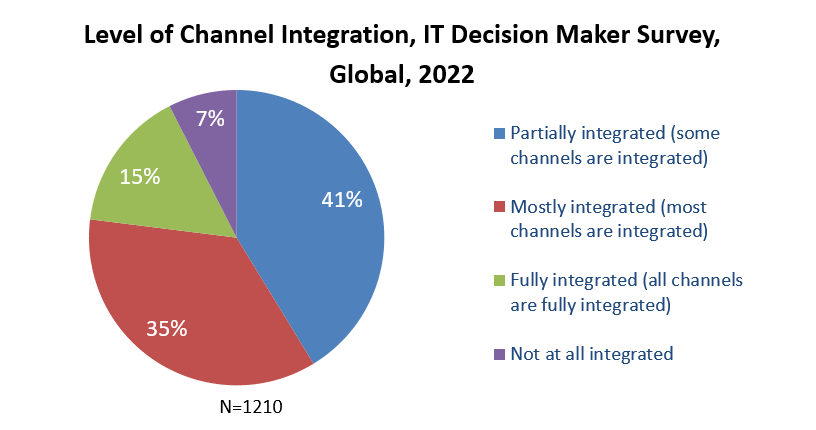Frost & Sullivan held yet another successful customer contact event, with executives staying engaged throughout the three days of interactive sessions. Many participants enthusiastically shared that the event was “amazing” and like no other event they have attended. The myriad of opportunities to engage with others, along with the “openness’’ of participants willing to share their successes and challenges, created a very collaborative environment. Executives learned from each other, developed relationships with potential partners and customers, and even made friends.
Events included not only excellent CX thought leader keynotes from various industries but also roundtables, panel discussions think tanks, one-on-one meetings, a “speed-dating” type of opportunity called the solutions wheel for quick introductions, fireside chats, and the Annual Olympics where executives teamed up and participated in competitive (and fun!) games.
This paper will provide the top takeaways from this insightful event and showcase some real-life examples of companies that successfully managed the challenges that COVID-19 brought forth and their plans to manage through the economic downturn companies are dealing with today.
Building a Customer-Centric Culture
Creating a Collaborative Environment is a Game Changer
Why is this important? Because “customers use their feet with their feedback,” according to Jasmine Green, Vice President of Enterprise Customer Solutions and Enablement, Nationwide. Enhancing the customer experience is everyone’s job and involves listening to associates, customers, and intermediaries. Nationwide achieves this level of collaboration by:
- Creating a blueprint and process to gain insights and perspectives from within the organization
- Providing a feedback portal to gather, listen to, and analyze associate feedback
- Sharing key findings with applicable business units.
- Applying what is learned prioritizing opportunities and creating next steps and action items
- Evaluating improvement through CX metrics
- Communicating how the company will act on the feedback – employees want to know!
The Power of Agents with High Emotional Intelligence in Delivering Excellent CX
Michael Shaw, Chief Brand Officer, Former Head of CX at Miami Marlins, ESPN, Amazon, and Groupon Alumni, is an expert on emotional intelligence. He shared valuable insight on the importance of high emotional intelligence in agents. Keeping customers engaged and feeling connected with a brand is crucial. Beyond handling queries quickly and efficiently, agents are required to be:
- Patient listeners so they can home in on what the customer really needs
- Adaptable to handle queries in various, unpredictable conditions; this requires companies to empower agents to use their creativity to resolve issues
- Effective oral speakers so that customers can understand them clearly
Creating a positive environment goes a long way in ensuring employees are happy since it impacts the energy they convey to customers. Shaw says, “Treating everyone like a customer transforms the environment. People remember how you made them feel – do you provide positive relational energy? Do you make them feel drained or energized?”
Establishing Successful Hybrid Models
Humans are highly adaptable, so we have adjusted to the new normal. We have learned to savor personal time and enjoy the reduced stress of not commuting. While balancing work-from-home (WFH) and on-site agents is challenging, success is possible because agents are resilient.
Michele Kerr, Senior Director, National Contact Center, TIAA, says, “Agents got creative with gaming the system when at home, so managing and maintaining agent metrics became even more essential.” AI-infused solutions are available to provide effective remote training and onboarding.
Other obstacles include:
- Creating emotional connection and loyalty – Kerr offers several suggestions:
- Online scavenger hunts, virtual breakout break rooms, virtual pumpkin carving, or other favorite holiday activities
- Continued and consistent communication with town halls – people want to know what’s going on with the business
- Diligently protecting customer data – the number one challenge for IT since the pandemic has been managing the level of security with employees in numerous locations and with so many offsite. There are tools available to minimize the risk of fraud and data leaks, including new uses of the camera and authentication methods
- Balancing the needs of the agent and the business; while hiring remote agents creates a broader net to find the best talent, it’s also challenging to keep WFH agents connected to the company, making agent attrition a more significant issue.

“If you are not flexible, quite simply put, you will lose your agents, your CSR’s will go elsewhere. It really is that simple. The market and the workforce have changed considerably, and you must change with it.”
Natalie Beckerman, Leaf Home
I had an engaging fireside chat with Natalie Beckerman, Senior Vice President of Global Call Center Operations at Leaf Home, about the importance of agility in contact centers today. Her advice should be heeded as companies create hybrid models. She says, “Be flexible, be agile, and fit with what your workforce wants. Many can’t work at home, want to shift to work from home, or need flexible hours. Be open to all changes. It’s us, the employers, who need to be agile. Look at part-time options, shift shares, rotational shifts, and all the workforce management (WFM) strategies we have thrown out in the past. Ask yourself, why do my people need to be in the office? If you are not flexible, quite simply put, you will lose your agents; your customer service representatives (CSRs) will go elsewhere. The market and the workforce have changed considerably, and you must change with it.”
When evaluating the right balance of WFH and on-site agents for your organization, keep in mind that you will always have competition from other companies that allow WFH. In other words, it must be part of your workforce strategy. When hiring, determining the environment agents prefer is crucial information.
Employee Engagement Became a Crucial Corporate Objective in 2022
The hottest topic of the week was about keeping employees engaged. Frost & Sullivan’s 2022 research found that employee engagement rose from the bottom to number 4 as a top business priority. Brian Saylor, Senior Vice President, Director of Contact Center Operations at Sandy Spring Bank, said it well, “Hire the heart, train the brain.”
Moreover, Saylor offered some great tips on traits to seek when hiring new talent:
- Effective listening skills– Beyond just listening to customers, agents should know how to “read the room” to understand how the customer is feeling
- Self-awareness– Understanding their frustrations and how to deal with them is crucial in the contact center world; being an agent can be emotionally taxing as there are always difficult customers, and stress is a top reason for high attrition rates
- Self-confidence – When armed with the training and knowledge they need, confident agents can more effectively handle tough situations
- Socially aware– Agents must be empathetic and can form connections with other employees (because they are more likely to stay with the company longer) and customers (to improve brand loyalty)
- Self-management– When agents are goal-oriented and self-motivated, they thrive in highly metrics-based contact center environments
Vanessa Neurohr, Vice President of Customer Success at Muck Rack, advocates making connections happen quickly – like during onboarding. Starting the company on a positive note with a desirable corporate culture goes a long way in developing longer-term employees.
“Trust is built and maintained by many small actions over time.”
Vanessa Neurohr, Muck Rack
David Weisman, Ph.D., CPXP, Chief Experience Officer, NYC Health + Hospitals, finds that “positive reinforcement works much better than sticks” and suggests three constructive steps: mentor, coach, and reinforce. Several speakers talked about needing to repeat instructions over and over for them to be remembered. Weisman adds that organizations should focus on “finding the pebbles in a shoe, which can more easily be fixed than boulders that stand in the way.” This way, employees feel heard and see positive changes continually. Boulders require planning, funding, and resources. They are also crucial in the long run, but small wins go a long way.
Neurohr is also a proponent of small steps, as she says, “Trust is built and maintained by many small actions over time.”

Other ways to keep employees engaged and happy:
- Recognize good work – give authentic kudos and incentivize to exceed targets; friendly competition is good and helps you find the best employees
- Empower employees (especially the best) – give them the tools to make better decisions on their ow
- Provide them with a process to share feedback so employees feel connected to the company’s goals
- Give them purpose-driven goals, so they have more meaning, which will be more compelling to employees to reach them
- Consider offering split shifts, allowing agents to get shifts covered on their own; some companies have been able to cover more prime hours by allowing for 10 hours a day/4 days a week
- In the end, culture and benefits are nice, but it’s critical to have competitive compensation
The New Rules of Training
As the younger generations enter the job market, companies must adapt their training modules to teach them in a way they want to learn. In a lively roundtable session with Candace Sheitelman, Chief Marketing Officer of Edify, we surmised that the generational gap is shrinking. Almost everyone has a low attention span and wants to absorb content in small bites.

Leveraging technology to deliver modularized learning is the way to meet today’s workforce’s needs. Lessons can be quicker and more fun if offered in an incentivized or gamified fashion.
According to Saylor, “Employees must be able to adapt to new technologies, have outside-of-the-box thinking, empathy training, and vertical and horizontal career advancement.” Coaching up or coaching out is a practical strategy. It means it’s okay to weed out agents who cannot display these capabilities during the early training phase. In the long run, this prevents spending money on fully training agents that are not a good fit.
Many contact center leaders found simulators and demonstrations the best way to train employees. These real-life, interactive methods make it easier for agents to remember what they learned. Some people are visual learners and learn more effectively when they can see what they need to do on a call perhaps on a video, rather than read about it.
Companies are advised to build bench strength so that employees are continually trained for new skills, allowing them to be more flexible to fill key positions and handle the most critical tasks when absences, attrition, or unexpected events occur. This includes improving the competencies required for supervisor and management roles. The added benefit is that when employees have a career path and feel valued, they will stay with the company longer.
Automation Anxiety
The COVID-19 pandemic has forced companies across sectors to lean on self-service more than ever. It has also accelerated contact centers to invest in AI, chatbots, virtual agents, and speech analytics. Today’s companies want to take advantage of these solutions and still deliver excellent customer care through self-service tools.
Other benefits of self-service tools are that they don’t call in sick and make fewer mistakes. However, nuances in speech still need to be understood by bots.

Even older people are now using self-service and mobile devices. When they don’t know how to use these solutions, they ask their kid or grandchild for help, but they do use them. This means that companies must provide mobile-friendly and seamless self-service solutions.
Sure, many processes and interactions are being automated. That does not been that companies should reduce the workforce. It’s better to create jobs with different skill sets to improve customer experiences. Bots don’t create anything, and they are not empathetic. Saylor said, “Processes must be holistic, data must be managed, and authentication should be simplified; technologies should make life easier for agents with solutions like a single pane of glass and CRM/API integration.”
The Last Word on Digital Transformation in CX
Delivering an end-to-end customer journey is crucial to creating a 360-degree view, yet only 15% of companies have fully integrated all of their channels. Many thought leaders recommend starting with a transformation plan that gives you the most significant impact quickly.

Holly Wendt, Americas Senior Operations Leader – Device, Digital, and Alexa Support of Amazon, recommends, “Let your agent, not your leaders, decide on what to prioritize in your digital transformation.”
The 18th Annual Customer Contact West: A Frost & Sullivan Executive MindXchange left participants with lots to think about, but here are a few common themes to consider as you plan and make CX investments for 2021:
- Empower the best – rewards multiply when they stay on for the long term, become your champions when you roll out new technologies, and create a positive environment for others
- Know when to bot and when not to bot – this is critical; push self-service but recognize that there are customers in situations that will always require voice
- Bring your best along for the ride throughout the digital transformation process — they will have great insight and prevent issues after implementation
“Let your agent, not your leaders, decide on what to prioritize in your digital transformation.”
Holly Wendt, Amazon



